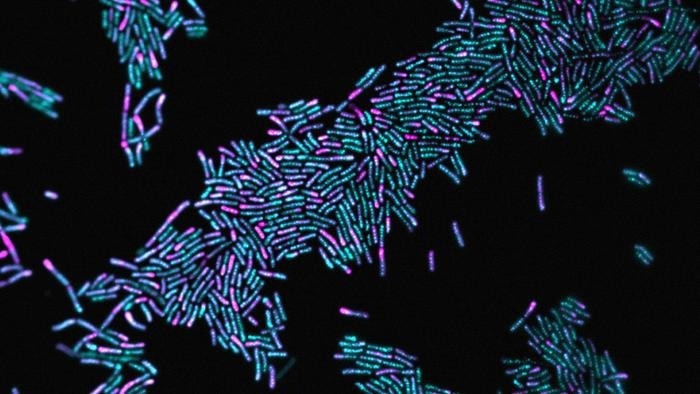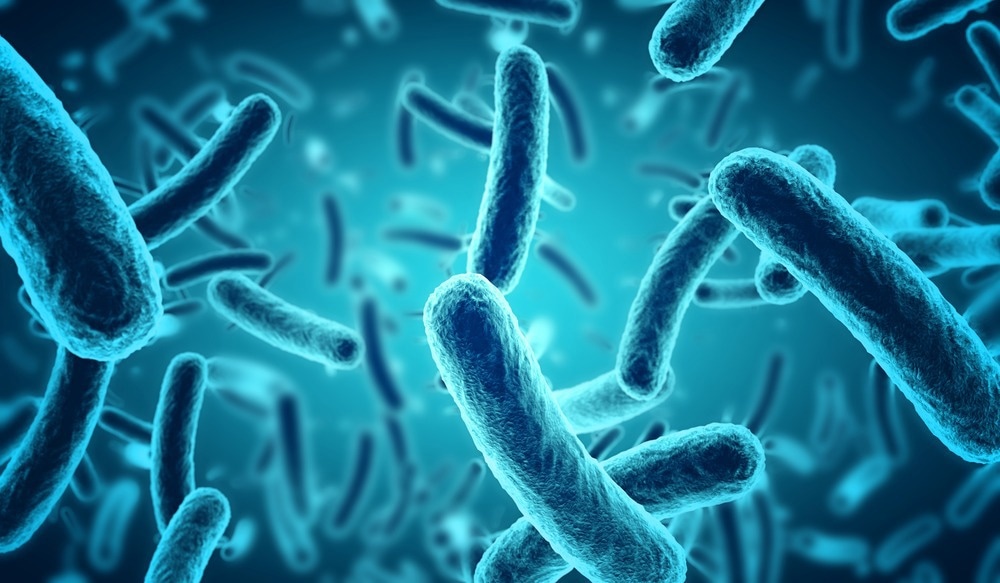Reviewed by Danielle Ellis, B.Sc.Aug 23 2023
Bacteria can be found almost everywhere on the planet, including in soil, water, acidic hot springs, and even people’s own stomachs.
 Bacteria with organelles called carboxysomes stained in cyan. Magenta indicates positioning systems organizing the cell. Image Credit: Vecchiarelli lab, University of Michigan
Bacteria with organelles called carboxysomes stained in cyan. Magenta indicates positioning systems organizing the cell. Image Credit: Vecchiarelli lab, University of Michigan
Numerous individuals participate in basic processes such as nitrogen fixation, breakdown, and fermentation. But how bacteria cells organize themselves before division is a crucial mechanism that scientists are still unable to fully comprehend.
Driving vs. Surfing
When cells divide, the original cell divides into two “daughter cells” with identical genetic material.
The DNA and other cellular components duplicate during this process, and then this “cargo” is sent to opposing ends of the cell.

Image Credit: paulista/Shutterstock.com
Once everything is in place, the cell divides into two identical daughter cells.
It is generally understood how eukaryotes (the cell type found in mammals, plants, fungi, and certain unicellular creatures) transport cellular cargo. Protein motors move DNA and organelles to opposing ends of the cell by driving along “highways” comprised of proteins termed actin filaments and microtubules.
Bacteria lack microtubules and actin filaments, yet they may nevertheless coordinate movement within the cell.
Anthony Vecchiarelli, PhD, found it amazing as a student that “we don’t know how things move within a cell for a whole domain of life.”
Vecchiarelli, who is currently an assistant professor in the University of Michigan Department of Molecular, Cellular and Developmental Biology, and an affiliate faculty member in the University of Michigan Medical School Department of Biological Chemistry, led a study to better understand the organization and coordination of movement within a bacterial cell.
Researchers at the University of Michigan discovered that certain bacteria transport cellular cargo by “surfing” alongside ParA/MinD ATPases.
Each cargo has its own specific “surfboard” since these proteins, or “positioning systems,” are even devoted to conveying a particular cellular component.
These acts, known as “positioning reactions,” can have an impact on one another and provide information about how bacteria coordinate intricate motions in the cell before cell division.
Nature Communications published the findings.
A Model Bacteria
Since model species commonly employed in research to understand biological processes do not have many positioning systems, the research team first had to locate a bacterium to examine.
A lot of the models that we use to understand how bacteria work suggested that there wasn’t really any intricate organization for all of these cargos. There are some bacteria like plain old E. coli that seems to segregate its chromosomes without an active segregation system.”
Anthony Vecchiarelli, PhD, Assistant Professor, Department of Molecular, Cellular and Developmental Biology, University of Michigan
The initial step in determining the frequency of active positioning systems was to use bioinformatics methods to sort through genetic data across microorganisms.
Vecchiarelli added, “We found over a third of all sequenced bacteria do encode for multiple positioning systems for multiple disparate cargos in the same cell. E. coli is an exception to the norm.”
Since it possesses seven separate positioning systems for seven different cargos, the research team chose the bacteria Halothiobacillus neapolitanus to analyze.
Graduate student Lisa T. Pulianmackal, who works with Vecchiarelli, found how to grow this bacterial species in the lab and fluorescently mark five cargos, enabling the researchers to track the cargos’ movement within living cells as they go through cell development and division.
To demonstrate how each positioning system is dedicated to a certain cargo, she then removed each system.
The next step was to examine these cargo movements at the systems level to determine how they interacted with one another.
Systems Biology Approach
Researchers frequently concentrate on a specific biological process. They introduce a mutation and then check to see if that particular process is affected. This method could overlook the indirect effects of that mutation.
This study is one of the first to examine spatial structure in a bacterial cell using a systems biology methodology.
Vecchiarelli further noted, “We find that there is a lot of crosstalk, interdependencies, and coordination among these organizing processes. That is why the systems biology approach is so important.”
Future Applications
The results present promising new opportunities for biotechnological advancements.
An ATPase and its adapter protein, or surfboard, which links to the cargo, make up each positioning system. This presents a chance to create a synthetic biology instrument that would let scientists connect to the adapter and place any cargo of their choice.
“Now that we identified five different positioning systems that work together, we are hoping to develop a synthetic biology toolset for positioning a wide variety of synthetic as well as natural cargos in bacteria for biotechnological applications,” Vecchiarelli further added.
Additionally, researchers intend to look at how pathogens—bacteria that cause disease—and other medically significant germs transfer their cargo.
Vecchiarelli concluded, “For bacterial pathogens, understanding how to break the surfboard can help us design new antibiotics.”
Source:
Journal reference:
Pulianmackal, L. T., et al. (2023). Multiple ParA/MinD ATPases coordinate the positioning of disparate cargos in a bacterial cell. Nature Communications. doi.org/10.1038/s41467-023-39019-x